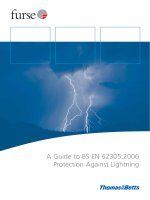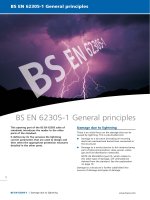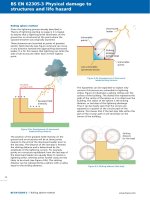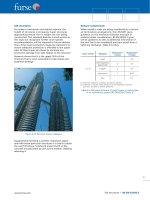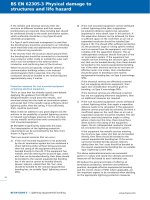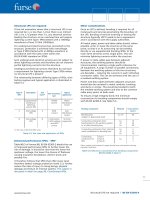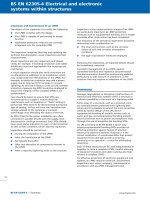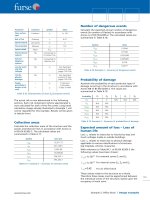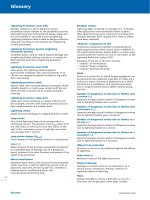Bsi bs en 00725 3 1994 (1999)
Bạn đang xem bản rút gọn của tài liệu. Xem và tải ngay bản đầy đủ của tài liệu tại đây (349.75 KB, 12 trang )
BRITISH STANDARD
Advanced technical
ceramics — Methods of
test for ceramic
powders —
Part 3: Determination of the oxygen
content of non-oxides by thermal
extraction with a carrier gas
The European Standard EN 725-3:1994 has the status of a
British Standard
UDC 666.3-121:620.1:546.21
BS EN
725-3:1994
BS EN 725-3:1994
Cooperating organizations
The European Committee for Standardization (CEN), under whose supervision
this European Standard was prepared, comprises the national standards
organizations of the following countries:
Austria
Belgium
Denmark
Finland
France
Germany
Greece
Iceland
Ireland
Italy
Luxembourg
Netherlands
Norway
Portugal
Spain
Sweden
Switzerland
United Kingdom
This British Standard, having
been prepared under the
direction of the Refractory
Products Standards Policy
Committee, was published
under the authority of the
Standards Board and comes
into effect on
15 May 1994
© BSI 11-1999
The following BSI references
relate to the work on this
standard:
Committee reference RPM/14
Draft for comment 92/39462 DC
ISBN 0 580 22393 0
Oesterreichisches Normungsinstitut
Institut belge de normalisation
Dansk Standardiseringsraad
Suomen Standardisoimisliito, r.y.
Association franỗaise de normalisation
Deutsches Institut für Normung e.V.
Hellenic Organization for Standardization
Technological Institute of Iceland
National Standards Authority of Ireland
Ente Nazionale Italiano di Unificazione
Inspection du Travail et des Mines
Nederlands Normalisatie-instituut
Norges Standardiseringsforbund
Instituto Portugs da Qualidade
Asociación Espola de Normalización y Certificación
Standardiseringskommissionen i Sverige
Association suisse de normalisation
British Standards Institution
Amendments issued since publication
Amd. No.
Date
Comments
BS EN 725-3:1994
Contents
Cooperating organizations
National foreword
Foreword
Text of EN 725-3
National annex NA (informative) Committees responsible
© BSI 11-1999
Page
Inside front cover
ii
2
3
Inside back cover
i
BS EN 725-3:1994
National foreword
This British Standard has been prepared under the direction of the Refractory
Products Standards Policy Committee and is the English language version of
EN 725-3:1994, Advanced technical ceramics — Methods of test for ceramic
powders — Part 3: Determination of the oxygen content of non-oxides by thermal
extraction with a carrier gas, published by the European Committee for
Electrotechnical Standardization (CEN).
EN 725-3 was produced as a result of international discussions in which the UK
took an active part.
A British Standard does not purport to include all the necessary provisions of a
contract. Users of British Standards are responsible for their correct application.
Compliance with a British Standard does not of itself confer immunity
from legal obligations.
Summary of pages
This document comprises a front cover, an inside front cover, pages i and ii,
the EN title page, pages 2 to 6, an inside back cover and a back cover.
This standard has been updated (see copyright date) and may have had
amendments incorporated. This will be indicated in the amendment table on the
inside front cover.
ii
© BSI 11-1999
EUROPEAN STANDARD
EN 725-3
NORME EUROPÉENNE
January 1994
EUROPÄISCHE NORM
UDC 666.3-121:620.1:546.21
Descriptors: Ceramics, powdery materials, chemical analysis, determination of content, oxygen, extraction methods, reduction
methods, carbon monoxide
English version
Advanced technical ceramics — Methods of test for
ceramic powders — Part 3: Determination of the oxygen
content of non-oxides by thermal extraction with a carrier
gas
Céramiques techniques avancées — Méthodes
d’ essai pour poudres céramiques — Partie 3:
Détermination de la teneur en oxygène de
poudres non-oxydes par extraction à chaud
sous gaz porteur
Hochleistungskeramik — Prüfverfahren für
keramische Pulver — Teil 3: Bestimmung des
Sauerstoffgehaltes in Nichtoxid-Pulvern
mittels Trägergasheißextraktion
www.bzfxw.com
This European Standard was approved by CEN on 1994-01-10. CEN members
are bound to comply with the CEN/CENELEC Internal Regulations which
stipulate the conditions for giving this European Standard the status of a
national standard without any alteration.
Up-to-date lists and bibliographical references concerning such national
standards may be obtained on application to the Central Secretariat or to any
CEN member.
This European Standard exists in three official versions (English, French,
German). A version in any other language made by translation under the
responsibility of a CEN member into its own language and notified to the
Central Secretariat has the same status as the official versions.
CEN members are the national standards bodies of Austria, Belgium,
Denmark, Finland, France, Germany, Greece, Iceland, Ireland, Italy,
Luxembourg, Netherlands, Norway, Portugal, Spain, Sweden, Switzerland and
United Kingdom.
CEN
European Committee for Standardization
Comité Européen de Normalisation
Europäisches Komitee für Normung
Central Secretariat: rue de Stassart 36, B-1050 Brussels
© 1994 Copyright reserved to CEN members
Ref. No. EN 725-3:1994 E
EN 725-3:1994
Foreword
This European Standard has been prepared by
Technical Committee CEN/TC 184, Advanced
technical ceramics, the secretariat of which is held
by BSI.
EN 725 consists of 11 Parts:
— Part 1: Determination of impurities in
alumina;
— Part 2: Determination of impurities in barium
titanate (ENV);
— Part 3: Determination of oxygen content of
non-oxides by thermal extraction with a carrier
gas;
— Part 4: Determination of oxygen content in
aluminium nitride by XRF analysis (ENV);
— Part 5: Determination of particle size
distribution;
— Part 6: Determination of the specific surface
area;
— Part 7: Determination of absolute density;
— Part 8: Determination of tapped bulk density;
— Part 9: Determination of untamped bulk
density;
— Part 10: Determination of compaction
properties;
— Part 11: Determination of densification on
natural sintering (ENV).
This document was submitted for the Formal Vote
and approved as a European Standard.
This European Standard shall be given the status of
a national standard, either by publication of an
identical text or by endorsement, at the latest by
July 1994, and conflicting national standards shall
be withdrawn at the latest by July 1994.
In accordance with the CEN/CENELEC Internal
Regulations, the following countries are bound to
implement this European Standard: Austria,
Belgium, Denmark, Finland, France, Germany,
Greece, Iceland, Ireland, Italy, Luxembourg,
Netherlands, Norway, Portugal, Spain, Sweden,
Switzerland and United Kingdom.
2
Contents
Foreword
1
Scope
2
Principle
3
Apparatus
4
Sample preparation
5
Procedure
6
Blank determination
7
Calibration
8
Test report
Annex A (informative) Guidance in
the selection of test conditions
Page
2
3
3
3
3
3
3
3
4
5
www.bzfxw.com
© BSI 11-1999
EN 725-3:1994
1 Scope
4 Sample preparation
This Part of EN 725 describes a method for the
determination of the oxygen content of non-oxide
powders used for advanced technical ceramics,
using an inert carrier gas thermal extraction
method. The method is suitable for oxygen contents
of less than 3 %
Take a sample of the dry powder, the quantity taken
being based on the detection limit of the apparatus
used for gas analysis and on the expected oxygen
content of the powder.
NOTE The limits of determination are given by the
manufacturers of the apparatus.
2 Principle
A test piece is heated in a graphite crucible at a high
temperature in a flow of an inert carrier gas. Oxygen
in the sample is converted to oxides of carbon, which
are extracted and transformed to consist entirely of
either carbon monoxide or carbon dioxide. This
volume is then determined by a suitable method of
gas analysis.
NOTE Guidance on the selection of test conditions is given
in Annex A.
3 Apparatus
3.1 Graphite crucible, which is used as a carbon
source. The crucible is capable of being electrically
heated by two electrodes, or by induction.
NOTE For example, for infrared absorption (see 3.4 e), samples
of 100 mg to 300 mg are required.
Use a scoop to handle the powder and place the
sample either directly in the crucible or in the tin
capsule. If the capsule is used, squeeze it to expel air
and then fold over the open end several times,
weighing again after squeezing.
5 Procedure
5.1 Heat the empty graphite crucible inside the
furnace to a temperature greater than the
temperature for analysis. Record the flow of gas
used in the furnace.
NOTE 1 This is to prevent additional degassing of the crucible
during the test run, which would produce errors.
NOTE 2 A recommendation for gas flow will normally be given
by the manufacturer of the instrument.
Cool to ambient temperature.
5.2 Place the tin capsule and sample in the crucible.
Select a temperature which is high enough to
dissociate the oxides to be determined
(see Annex A). Use the nickel wire basket (see 3.3) if
the preliminary tests suggest that it is necessary.
Heat the furnace to the test temperature and record
the temperature and the time at temperature.
Collect the gas evolved and measure the amount,
using one of the analytical techniques listed in 3.4.
5.3 Repeat the procedure given in clause 4 and
subclause 5.2 at least four times.
www.bzfxw.com
3.2 Tin capsule, (optional) to contain the ceramic
powder sample.
3.3 Nickel wire basket, (optional) for use as a fluxing
agent with certain powders such as aluminium
nitride.
3.4 Gas analysis apparatus, based on one of the
following techniques:
a) volumetric analysis, for measurement of
carbon monoxide gas;
b) chromatography, for carbon monoxide;
c) thermal conductivity, for carbon monoxide and
carbon dioxide;
d) coulometric analysis, for carbon dioxide;
e) infrared absorption, for carbon dioxide.
3.5 Furnace, normally capable of reaching at
least 2 500 °C operating in an inert gas atmosphere
(nitrogen, helium or argon).
NOTE Apparatus which does not achieve 2 500 °C may be used
for lower test temperatures, but 2 500 °C will be needed to give
the correct result for certain types of material.
© BSI 11-1999
6 Blank determination
Carry out a blank determination for the apparatus
whenever the gas supply or crucible batch is
changed. Use the procedure given in clause 5 and
record the amount of gas evolved. Use this blank
value to calculate the results for the sample
analysis.
7 Calibration
Calibration shall be carried out preferably by using
a reference material of certified oxygen content to
calibrate the furnace and gas analysis equipment,
using the procedure given in clause 5.
An alternative method is to use a sample of pure
carbon monoxide or carbon dioxide gas to calibrate
the gas analysis equipment, with a minimum of
three results being recorded.
3
EN 725-3:1994
8 Test report
The test report shall include the following
information:
a) the name of the test establishment;
b) the date of the test, a unique identification of
the report, the name and address of the customer,
a signatory of the report;
c) a reference to this European Standard,
i.e. determined in accordance with EN 725-3;
d) a description of the test material
(manufacturer, type, batch or code number);
e) the type of analytical equipment used (see 3.4);
f) the method of calibration (see clause 7);
g) the purity of the carrier gas and gas used for
calibration;
h) the mass of the samples and reference to
optional use of the tin capsule (see 3.2);
i) the test temperature;
j) the individual values of oxygen content, mean
value and standard deviation:
k) comments about the test or test results.
www.bzfxw.com
4
© BSI 11-1999
EN 725-3:1994
Annex A (informative)
Guidance in the selection of test
conditions
Because of the large variety of ceramic powders in
use and number of analytical techniques available,
it is not possible to specify test conditions (amount
of sample, temperature, gas flow rate, analytical
technique) that will be applicable to every
determination. It is therefore recommended that the
optimum conditions for testing a material be
determined by preliminary tests. This may be done
by carrying out successive tests on the same test
sample, increasing the reducing action until the
measured oxygen content reaches a maximum,
constant value. Fluxing agents (see 3.3) may also be
used.
When the test conditions have been established, a
certified reference material of the same chemical
type as the test sample should be tested to check
these proposed conditions.
www.bzfxw.com
© BSI 11-1999
5
www.bzfxw.com
6
blank
BS EN 725-3:1994
National annex NA (informative)
Committees responsible
The United Kingdom participation in the preparation of this European Standard was entrusted by the
Refractory Products Standards Policy Committee (RPM/-) to Technical Committee RPM/14 upon which the
following bodies were represented:
British Ceramic Research Ltd.
British Industrial Ceramic Manufacturers’ Association
British Steel Industry
Bureau of Analysed Samples Limited
China Clay Association
Ministry of Defence
Refractories Association of Great Britain
Society of Glass Technology
© BSI 11-1999
BS EN
725-3:1994
BSI — British Standards Institution
BSI is the independent national body responsible for preparing
British Standards. It presents the UK view on standards in Europe and at the
international level. It is incorporated by Royal Charter.
Revisions
British Standards are updated by amendment or revision. Users of
British Standards should make sure that they possess the latest amendments or
editions.
It is the constant aim of BSI to improve the quality of our products and services.
We would be grateful if anyone finding an inaccuracy or ambiguity while using
this British Standard would inform the Secretary of the technical committee
responsible, the identity of which can be found on the inside front cover.
Tel: 020 8996 9000. Fax: 020 8996 7400.
BSI offers members an individual updating service called PLUS which ensures
that subscribers automatically receive the latest editions of standards.
Buying standards
Orders for all BSI, international and foreign standards publications should be
addressed to Customer Services. Tel: 020 8996 9001. Fax: 020 8996 7001.
In response to orders for international standards, it is BSI policy to supply the
BSI implementation of those that have been published as British Standards,
unless otherwise requested.
Information on standards
BSI provides a wide range of information on national, European and
international standards through its Library and its Technical Help to Exporters
Service. Various BSI electronic information services are also available which give
details on all its products and services. Contact the Information Centre.
Tel: 020 8996 7111. Fax: 020 8996 7048.
Subscribing members of BSI are kept up to date with standards developments
and receive substantial discounts on the purchase price of standards. For details
of these and other benefits contact Membership Administration.
Tel: 020 8996 7002. Fax: 020 8996 7001.
Copyright
Copyright subsists in all BSI publications. BSI also holds the copyright, in the
UK, of the publications of the international standardization bodies. Except as
permitted under the Copyright, Designs and Patents Act 1988 no extract may be
reproduced, stored in a retrieval system or transmitted in any form or by any
means – electronic, photocopying, recording or otherwise – without prior written
permission from BSI.
This does not preclude the free use, in the course of implementing the standard,
of necessary details such as symbols, and size, type or grade designations. If these
details are to be used for any other purpose than implementation then the prior
written permission of BSI must be obtained.
BSI
389 Chiswick High Road
London
W4 4AL
If permission is granted, the terms may include royalty payments or a licensing
agreement. Details and advice can be obtained from the Copyright Manager.
Tel: 020 8996 7070.
